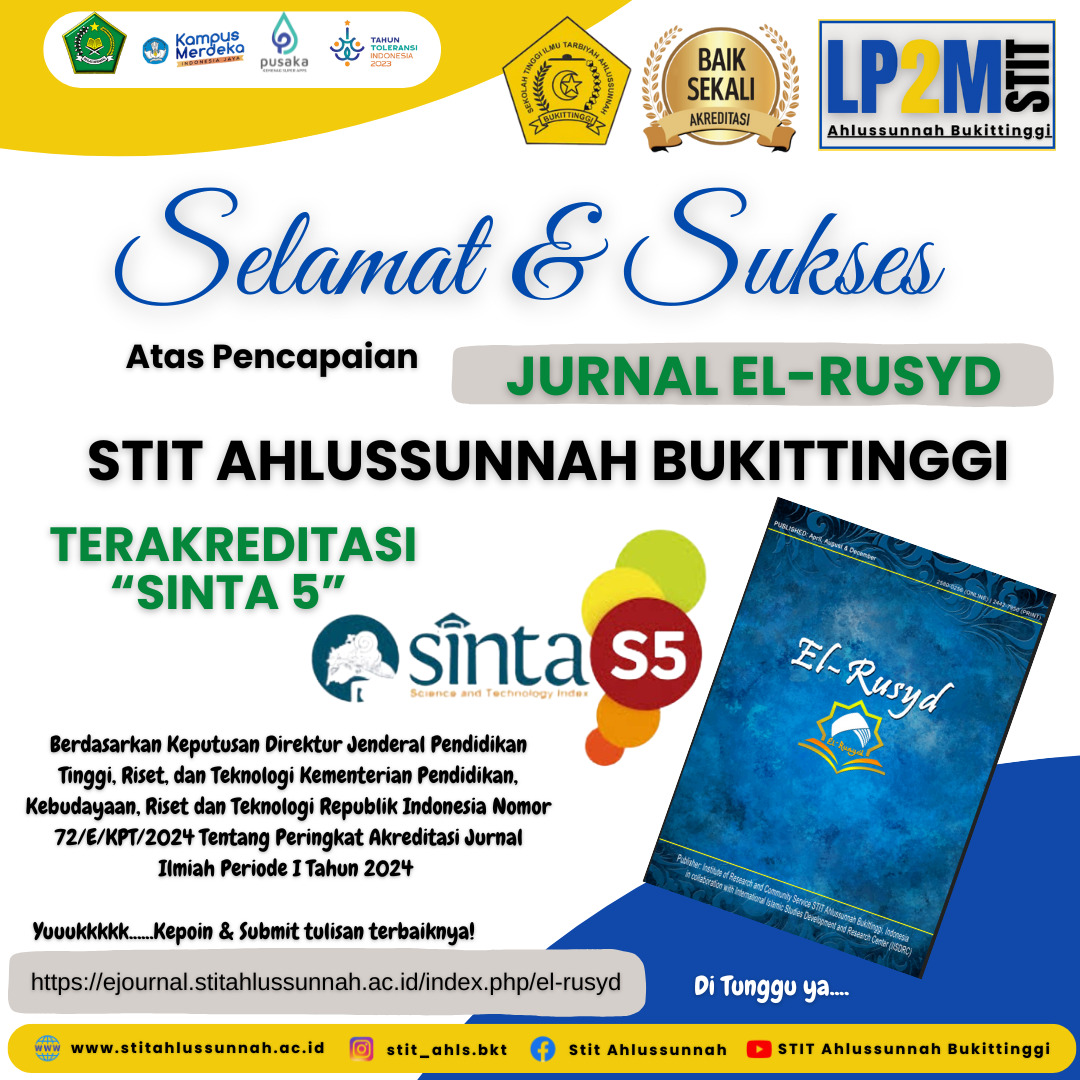Analysis of Early Marriage Satisfaction in Muslim Families
DOI:
https://doi.org/10.58485/elrusyd.v9i1.238Keywords:
Contentment, marriage, youthAbstract
Early marriage is a significant sociocultural phenomenon, especially among Muslims, which is influenced by various religious, economic, and social factors. This study aims to analyze the marital satisfaction of couples who married at a young age. This research was conducted using quantitative methods with a survey approach. The data source was taken using a questionnaire from 32 married couples who married at a young age with the category that the husband was under 25 years old at the time of marriage, while the wife was under 21 years old. All data was then analyzed using SPPS Windows Version 20 software. Overall, the statistical analysis results showed that 32 married couples stated that they were satisfied with their partners while building a household. Marital satisfaction in question is measured through six aspects, namely; aspects of communication, conflict resolution, finances, sexual relations, the role of each husband and wife in the family, and religious life. This means that the six aspects used as instrument items in this research were felt to be satisfactory by all married couple after getting married. The results of this study have at least refuted the assumption that marrying at a young age tends to fail. In other words, age at marriage does not determine success in the household. The success of a marriage is determined if the husband and wife know their respective roles and responsibilities well.
References
Abreu-Afonso, J., Ramos, M. M., Queiroz-Garcia, I., & Leal, I. (2022). How Couple’s Relationship Lasts Over Time? A Model for Marital Satisfaction. Psychological Reports, 125(3), 1601–1627. https://doi.org/10.1177/00332941211000651
Agusti, F. A., Zafirah, A., Engkizar, E., Anwar, F., Arifin, Z., & Syafril, S. (2018). the Implantation of Character Values Toward Students Through Congkak Game for Mathematics Instructional Media. Jurnal Penelitian Pendidikan, 35(2), 132–142. https://doi.org/10.15294/jpp.v35i2.13947
Akhiruddin. (2016). Dampak Pernikahan Usia Muda di Kasus Di Desa Mattirowallie libureng. Jurnal Mahkamah, 1(1), 205–222. https://doi.org/10.25217/jm.v1i1.38
Angin, Y. H. P., & Yeniretnowati, T. A. (2021). Implikasi Pemahaman Bahasa Cinta bagi Relasi Suami Istri. Jurnal Teologi (JUTEOLOG), 2(1), 168–183. https://doi.org/10.52489/juteolog.v2i1.17
Anwar, Z., & Rahmah, M. (2017). Psikoedukasi Tentang Risiko Perkawinan Usia Muda untuk Menurunkan Intensi Pernikahan Dini pada Remaja. Psikologia : Jurnal Psikologi, 1(1), 1. https://doi.org/10.21070/psikologia.v1i1.749
Ardhianita, I., & Andayani, B. (2015). Kepuasan Pernikahan Ditinjau dari Berpacaran dan Tidak Berpacaran. Jurnal Psikologi, 32(2), 101–111. https://doi.org/https://doi.org/10.22146/jpsi.7074
Ardiningrum, A. R., Mesrawati, F., Pradiafta, F. S., Hakim, F., Fajar, G. S., & Angreini, R. (2021). Phenomenological Study of Factors Causing Pre-Marriage Pregnancy among Adolescents. International Journal of Multidisciplinary Research of Higher Education, 4(2), 65–71. https://doi.org/10.24036/ijmurhica.v4i2.82
Belmi, P., Neale, M. A., Reiff, D., & Ulfe, R. (2020). The social advantage of miscalibrated individuals: The relationship between social class and overconfidence and its implications for class-based inequality. Journal of Personality and Social Psychology, 118(2), 254–282. https://doi.org/10.1037/pspi0000187
Bhattarai, P. C., Paudel, D. R., Poudel, T., Gautam, S., Paudel, P. K., Shrestha, M., Ginting, J. I., & Ghimire, D. R. (2022). Prevalence of Early Marriage and Its Underlying Causes in Nepal: A Mixed Methods Study. Social Sciences, 11(4), 177. https://doi.org/10.3390/socsci11040177
Bilal, A., & Rasool, S. (2020). Marital Satisfaction and Satisfaction With Life: Mediating Role of Sexual Satisfaction in Married Women. Journal of Psychosexual Health, 2(1), 77–86. https://doi.org/https://doi.org/10.1177/2631831820912873
Bożek, A., Nowak, P. F., & Blukacz, M. (2020). The Relationship Between Spirituality, Health-Related Behavior, and Psychological Well-Being. Frontiers in Psychology, 11. https://doi.org/10.3389/fpsyg.2020.01997
Bradbury, T., Rogge, R., & Lawrence, E. (2001). Reconsidering the Role of Conflict in Marriage. In Couples in Conflict (pp. 69–92). Routledge. https://doi.org/10.4324/9781410600134-12
Brandler, S., & Roman, C. P. (2020). Qualitative Research Methods. In Handbook of Research Methods in Public Administration. https://doi.org/10.1201/9781420013276-17
Breitenstein, C. J., Milek, A., Nussbeck, F. W., Davila, J., & Bodenmann, G. (2018). Stress, dyadic coping, and relationship satisfaction in late adolescent couples. Journal of Social and Personal Relationships, 35(5), 770–790. https://doi.org/10.1177/0265407517698049
Cantika, A., Syahrinanda, A., Pridayani, M., Zuriati, H., & Angsisca, N. (2018). The Phenomenon of Pre-Marriage Pregnancy Among Adolescents: An Analysis Regarding the Causes and Solutions. International Journal of Multidisciplinary Research of Higher Education, 1(1), 45–51. https://doi.org/https://doi.org/10.24036/ijmurhica.v1i1.94
Carson, M. L. S. (2017). Circumcision of the Heart: Extrinsic and Intrinsic Religiosity in Romans 1–5. The Expository Times, 128(8), 376–384. https://doi.org/10.1177/0014524617692461
Carter, J., & Duncan, S. (2017). Wedding paradoxes: Individualized conformity and the ‘perfect day.’ Sociological Review, 65(1), 3–20. https://doi.org/10.1111/1467-954X.12366
Charlot, L. A., Washington, K., & Hall, C. (2022). Exhumed: Reckoning with the History of Eugenics in Marriage and Family Therapy. The Family Journal, 30(4), 493–498. https://doi.org/10.1177/10664807221104113
Eekelaar, J. (2017). Family Law and Personal Life. In Family Law and Personal Life (Vol. 1). Oxford University Press. https://doi.org/10.1093/oso/9780198814085.001.0001
Engkizar, E., Alfurqan, A., Murniyetti, M., & Muliati, I. (2018). Behavior and Factors Causing Plagiarism Among Undergraduate Students in Accomplishing The Coursework on Religion Education Subject. Khalifa: Journal of Islamic Education, 1(1), 98. https://doi.org/10.24036/kjie.v1i1.8
Fallahchai, R., Fallahi, M., & Ritchie, L. L. (2017). The Impact of PREP Training on Marital Conflicts Reduction: A Randomized Controlled Trial With Iranian Distressed Couples. Journal of Couple & Relationship Therapy, 16(1), 61–76. https://doi.org/10.1080/15332691.2016.1238793
Frederick, D. A., Lever, J., Gillespie, B. J., & Garcia, J. R. (2017). What Keeps Passion Alive? Sexual Satisfaction Is Associated With Sexual Communication, Mood Setting, Sexual Variety, Oral Sex, Orgasm, and Sex Frequency in a National U.S. Study. The Journal of Sex Research, 54(2), 186–201. https://doi.org/10.1080/00224499.2015.1137854
Gottman, J., & Gottman, J. (2017). The Natural Principles of Love. Journal of Family Theory & Review, 9(1), 7–26. https://doi.org/10.1111/jftr.12182
Han, C. (2018). Quantitative research methods in translation and interpreting studies. The Interpreter and Translator Trainer, 12(2), 244–247. https://doi.org/10.1080/1750399X.2018.1466262
Harahap, S. R., & Lestari, Y. I. (2018). Peranan Komitmen Dan Komunikasi Interpersonal Dalam Meningkatkan Kepuasan Pernikahan pada Suami yang Memiliki Istri Bekerja. Jurnal Psikologi, 14(2), 120. https://doi.org/10.24014/jp.v14i2.5603
Karney, B. R., & Bradbury, T. N. (2020). Research on Marital Satisfaction and Stability in the 2010s: Challenging Conventional Wisdom. Journal of Marriage and Family, 82(1), 100–116. https://doi.org/10.1111/jomf.12635
Kwon, S. H. (2017). Green Can Be the New White for Wedding Dresses. Design Journal, 20(5), 595–616. https://doi.org/10.1080/14606925.2017.1349410
Lase, E. (2021). Peranan Konselor Mengatasi Perselingkuhan Dalam Hubungan Pernikahan Kristen. Excelsis Deo: Jurnal Teologi, Misiologi, Dan Pendidikan, 5(1), 59–70. https://doi.org/10.51730/ed.v5i1.65
Lavner, J. A., Weiss, B., Miller, J. D., & Karney, B. R. (2018). Personality change among newlyweds: Patterns, predictors, and associations with marital satisfaction over time. Developmental Psychology, 54(6), 1172–1185. https://doi.org/https://psycnet.apa.org/doi/10.1037/dev0000491
Leavitt, C. E., Hendricks, J. J., Clarke, R. W., Marks, L. D., Dollahite, D. C., & Rose, A. H. (2024). Integrity and fidelity in highly religious marriages. Family Relations, 73(3), 2134–2151. https://doi.org/10.1111/fare.12983
Lee, W.-S., & McKinnish, T. (2018). The marital satisfaction of differently aged couples. Journal of Population Economics, 31(2), 337–362. https://doi.org/10.1007/s00148-017-0658-8
Mallory, A. B., Stanton, A. M., & Handy, A. B. (2019). Couples’ Sexual Communication and Dimensions of Sexual Function: A Meta-Analysis. The Journal of Sex Research, 56(7), 882–898. https://doi.org/10.1080/00224499.2019.1568375
Margelisch, K., Schneewind, K. A., Violette, J., & Perrig-Chiello, P. (2017). Marital stability, satisfaction and well-being in old age: variability and continuity in long-term continuously married older persons. Aging & Mental Health, 21(4), 389–398. https://doi.org/10.1080/13607863.2015.1102197
Minuchin, S. (2018). The family in therapy. In Families and Family Therapy (pp. 85–94). Routledge. https://doi.org/10.4324/9780203111673-6
Murniyetti, M., Engkizar, E., & Anwar, F. (2016). Pola Pelaksanaan Pendidikan Karakter Terhadap Siswa Sekolah Dasar. Jurnal Pendidikan Karakter, 7(2), 156–166. https://doi.org/https://dx.doi.org/10.21831/jpk.v6i2.12045
Novianty, S., & Aditya, Y. (2020). Pengaruh gratitude terhadap kepuasan pernikahan. Jurnal Psikologi Ulayat, 1(2), 177–188. https://doi.org/10.24854/jpu10
Nyfhodora, F., & Soetjiningsih, C. H. (2021). Perbedaan Kepuasan Pernikahan Pada Pasangan Sama Etnis Dan Beda Etnis. Jurnal Ilmiah Bimbingan Konseling Undiksha, 12(2), 1–15. https://doi.org/10.23887/jibk.v12i2.36729
Onandia-Hinchado, I., Pardo-Palenzuela, N., & Diaz-Orueta, U. (2021). Cognitive characterization of adult attention deficit hyperactivity disorder by domains: a systematic review. Journal of Neural Transmission, 128(7), 893–937. https://doi.org/10.1007/s00702-021-02302-6
Putri, D. P. K., & Lestari, S. (2015). Pembagian peran dalam rumah tangga pada pasangan suami istri Jawa. Jurnal Penelitian Humaniora, 16(1), 72–85. https://doi.org/https://badge.dimensions.ai/details/doi/10.23917/humaniora.v16i1.1523?domain=https://journals.ums.ac.id
Reczek, C. (2020). Sexual‐ and Gender‐Minority Families: A 2010 to 2020 Decade in Review. Journal of Marriage and Family, 82(1), 300–325. https://doi.org/10.1111/jomf.12607
Rindfuss, R. R., & VandenHeuvel, A. (2019). Cohabitation: A Precursor to Marriage or an Alternative to Being Single? In The Changing American Family (pp. 118–142). Routledge. https://doi.org/10.4324/9780429309441-7
Ripley, J., Solfelt, L., Ord, A., Garthe, R. C., Worthington, E. L., & Channing, T. (2023). Short- and long-term outcomes of hope focused couple therapy. Spirituality in Clinical Practice, 10(4), 271–288. https://doi.org/10.1037/scp0000286
Sagiv, L., Roccas, S., Cieciuch, J., & Schwartz, S. H. (2017). Personal values in human life. Nature Human Behaviour, 1(9), 630–639. https://doi.org/10.1038/s41562-017-0185-3
Satrianis, S., Deswana, D., Hayati, S. N., & Aziz, A. (2021). The Phenomena of Pregnancy Out of Marriage Among Students and the Solution. International Journal of Multidisciplinary Research of Higher Education, 4(2), 59–64. https://doi.org/10.24036/ijmurhica.v4i2.110
Schlagintweit, H. E., Bailey, K., & Rosen, N. O. (2016). A New Baby in the Bedroom: Frequency and Severity of Postpartum Sexual Concerns and Their Associations with Relationship Satisfaction in New Parent Couples. The Journal of Sexual Medicine, 13(10), 1455–1465. https://doi.org/10.1016/j.jsxm.2016.08.006
Singmann, H., & Kellen, D. (2019). An Introduction to Mixed Models for Experimental Psychology. In New Methods in Cognitive Psychology (pp. 4–31). Routledge. https://doi.org/10.4324/9780429318405-2
Tanjung, A. A., & Ariyadi, A. (2021). Hubungan Dalam Pernikahan Jarak Jauh Menurut Hukum Islam. Mitsaqan Ghalizan, 1(1), 56–71. https://doi.org/10.33084/jmg.v1i1.2851
Taufik, T., & Hariko, R. (2017). Gambaran Permasalahan Pasangan Muda di Kabupaten Kerinci. JKI (Jurnal Konseling Indonesia), 3(1), 1–8. https://doi.org/10.21067/jki.v3i1.1974
Tavakol, Z., Behboodi Moghadam, Z., Nikbakht Nasrabadi, A., Salehiniya, H., & Rezaei, E. (2017). A Review of the Factors Associated with Marital Satisfaction. Galen Medical Journal, 6(3), 176–185. https://doi.org/10.31661/gmj.v6i3.641
Tyas, F. P. S., Herawati, T., & Sunarti, E. (2017). Tugas Perkembangan Keluarga dan Kepuasan Penikahan pada Pasangan Menikah Usia Muda. Jurnal Ilmu Keluarga Dan Konsumen, 10(2), 83–94. https://doi.org/10.24156/jikk.2017.10.2.83
Utomo, A. J., Reimondos, A., Utomo, I. D., McDonald, P. F., & Hull, T. H. (2016). Transition into marriage in Greater Jakarta: Courtship, parental influence, and self-choice marriage. South East Asia Research, 24(4), 492–509. https://doi.org/https://doi.org/10.1177/0967828X16674134
Widmer, E. D. (2016). Family Configurations. In Family Configurations. Routledge. https://doi.org/10.4324/9781315581903
Wilcox, W. B., & Wolfinger, N. (2016). Soul Mates: Religion, Sex, Love, and Marriage among African Americans and Latinos. In Contemporary Sociology: A Journal of Reviews (Vol. 46, Issue 2). Oxford University Press. https://doi.org/10.1177/0094306117692573ss
Zafirah, A., Agusti, F. A., Engkizar, E., Anwar, F., Alvi, A. F., & Ernawati, E. (2018). Penanaman Nilai-Nilai Karakter terhadap Peserta Didik Melalui Permainan Congkak sebagai Media Pembelajaran. Jurnal Pendidikan Karakter, 9(1), 95–104. https://doi.org/10.21831/jpk.v8i1.21678











